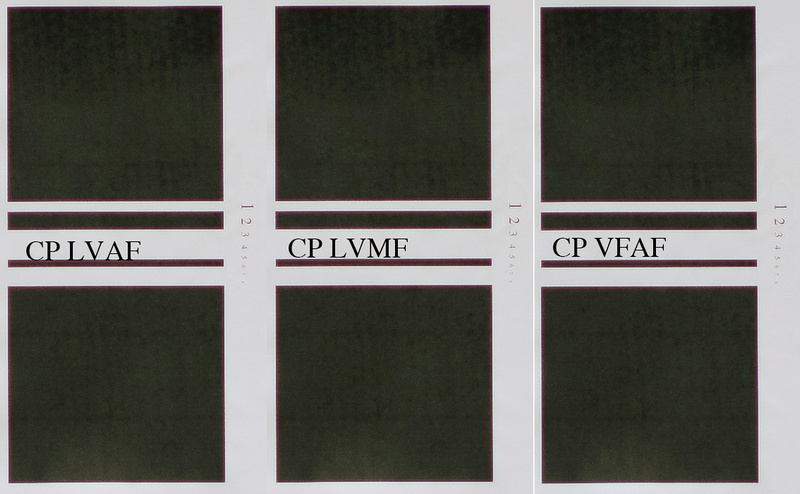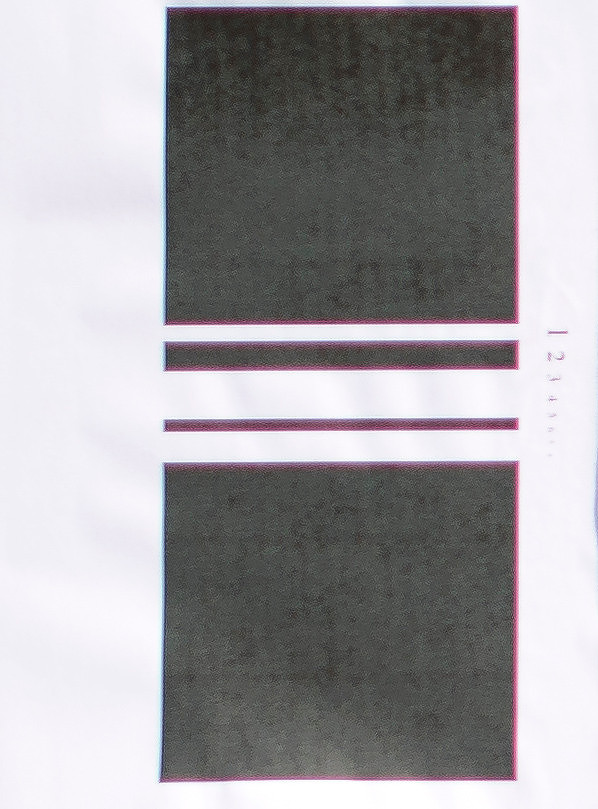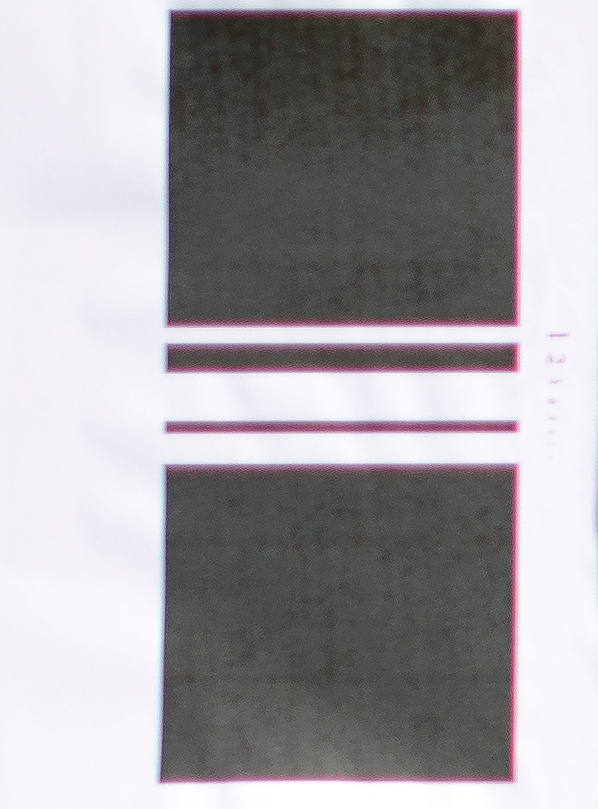D800: the Second Fix result.As reported in yesterday's post, Nikon managed to receive my request for a second go at 'the Left Point AF Fix' and not only pick the camera up by courier but also repair and return it to me within one working week. Astonishingly good. But did it work? Hmmm. Brief recap: before the 'first fix' at Nikon UK HQ, the left point was back focussing by a lot. The centre point was great, and the right point was pretty damned good. After the first fix, the centre point was still great but though the left point was better, it was still nowhere near as good as it should be and the right point had got worse. A balancing act had been performed that was not at all to my liking: making the right point worse screws up your ability to focus on an eye in the studio in portrait orientation. Today I took the camera for a quick test shoot of various targets and it was notably better, with the right point now looking fairly good and the left point looking promising but ambiguous. So I went 'real world' shooting at a variety of apertures for a while and got a bit of a sinking feeling: something still felt 'off'. At best, some of the Left Point shots, when viewed at 50% on screen, looked goodish but not great. Generally they were too soft to be acceptable for anything but small to possibly medium prints. The Right point was more consistent, if less good than the Centre Point. See below for more on this. A note on testing for this: I use a fast wide, the 28mm F1.8G, for the tests. This, like many fast wides, has focus shift as it stops down. This means that all shots taken at any aperture smaller than F1.8 should be considered irrelevant. The camera is not programmed to compensate, when using viewfinder Phase Detect AF, for focus shift. It might be a nice idea but to my knowledge no camera has this feature. Focus shift also combines in a complex way with the field curvature of lenses that exhibit this characteristic, which this lens does. That makes for a multifactorial situation, and the point of testing is to reduce the factors at play to one, if you can. Which means you can only shoot wide open if you want to assess accuracy. Then you need to be aware that fast wides, shot wide open, tend to be a somewhat soft - especially away from the centre. That means that you have to accept two things:
The ONLY relevant comparison is to make some shots using Live View focus over each of the Centre, Left and Right focus points, using an appropriate target, and thereby discover the 'best' that the lens can deliver AT EACH OF THOSE POINTS. Those shots can then be used as reference shots for the Viewfinder Phase Detect AF accuracy. There isn't even much point comparing the performance of VFAF by comparing shots taken using the Left and Right points: any problems with the lens itself may not be symmetrical. So: onto my test results. The target is A4 sized and shot from approximately 8 feet away on a very, very solid tripod rig. Method was:
The results are posted below but please note that I have run several sets of similar shots with differing real-world and printed targets in varying lighting conditions. Some targets with horizontal stripes, some with vertical, and so on. The results are consistent across all sets of tests. KEY:
Click on each image for a 100% sized file, at 91% JPEG quality
Note on Right Point results: you will note that the Live View Autofocus shot is OOF. Lloyd Chambers has questioned the accuracy of LVAF, and I tend to agree that it is not always reliable, though generally pretty good. I have included this data point to show the importance of making test images using LVMF too, if you want to show what the lens, rather than the camera, can achieve, when looking for a reference shot. You'll be best loading these into Lightroom or Capture One and having a close peep but what I see is that the Left Side is a tad less sharp and a tad less consistent than the Right. But I also see that the 'best' Live View shot on the Right is better than the best on the left. This could just be because this is a pig to focus and there is a slightly less optimal result on the left, or it could be that the lens is slightly and asymmetrically weaker on the left. If that's the case, all bets are off on making a clear judgement because not only does it mean that the Left will never be as sharp, it also means that the focus mechanism will never have as much to work with, and will therefore be less consistent. I have driven myself crazy trying to work out which and after quite a lot of shots, I think the lens is more or less symmetrical and I think therefore that the Left Point is slightly less accurate and consistent.
Some Further Data Points I mulled this over night and then ran two more tests: Firstly I used my 24-120 F4 VR, which I know to be reliable at the wide end. I shot the same sequences as above and, though the lens is less sharp at the area under the left point, as you would expect, it is pretty good: and there is NO notable difference, wide open at F4, between the Live View and the Viewfinder AF points: the AF system's left point is immaculate with this lens. This is almost certainly partly because of DOF effects on the result but also, more subtly, because the increased DOF makes the image inherently easier for the lens to focus. Also, this lens has no notable focus shift and no serious field curvature. Next I shot the 'twice fixed' D800 against the 'screwed and not fixed' D800E. Now: this D800E was similar to the pre-fix D800 in performance with this lens - so it makes a good proxy for seeing how much of an improvement there has been. Both these are identical, Left Point shots: same lens, same rig, different bodies. I shot five of each and the results were consistent so these shots are representative.
So, to the $64,000 question (actually, $2,999.9 at B&H at the moment): is it fixed? I don't know but it is possible.
It is certainly notably better. It isn't IMHO quite 'good enough'. But that has to do with my expectations rather than any test results I can produce: the only way to 'know' would be to set up an identical rig with a 'known good' D800 and see what happened. Anyone offering? Anyone offering a really good sample of a 24mm F1.4 for me to try? Bottom Line When I use this lens on this 'fixed' body with this wide angle, fast lens, whether it be wide open or stopped down, I have the constant sense that I can't trust it. It is so often close to good enough but it feels like a plump lady in a too-tight dress: it is always straining to escape. It feels like it has been adjusted to the furthest extent possible and is still not quite there and it is clear from my shooting that it is still trying to back focus and usually succeeding, just by far less than before. So I don't know if this is the best the design can do, or even if it's the best that this particular body could do without a hardware fix, which I don't believe this has had. But like I say I don't trust it with this lens... and for the reasons outlined above, this lens is a tough gig and may have its own slight asymmetry. It may be that fast wides, with their tendency to focus shift and their need for tiny movements of the focus mechanism and their weak mid field and edge performance wide open are just too much of a pig for any current 'peripheral' type AF sensor to deal with reliably. It may be that my expectations are too high or unrealistic at this price point. I cannot say. I need to shoot it more, with more lenses, under more lighting conditions, to form a more rounded view. But I have a small feeling it might end up going back again. I have a feeling that it could do better. In the meantime I am going to go out and shoot the camera and enjoy it because, whilst it might not (yet) be as good as it could be, it is still pretty amazing. What do you think? EDIT: a week or so later, after using the twice-repaired camera on a great variety of subjects and further evaluating it, I find that in the field, at pretty much all subject distances and on pretty much all subjects, it is back-focussing using the left point, to the extent that that point simply is of no practical use. I have also, after more exhaustive testing, found that at distance the 28mm F1.8G when focussed using Live View Manual, can come very, very close to the sharpness of the centre when focussed on subjects under the area covered by the left point. I therefore refine my conclusions above to indicate that at least at distance, the lens is sharp enough to give the sensor a very good chance of achieving focus but that it still fails to do so. For an example of this see my Focus and Recompose post. I therefore have to conclude, sadly, that despite Nikon UK's very fast and friendly service, this camera is still not performing satisfactorily. Either, given appropriate targets, the outer focus points are useful or they are not. Mine is not. Which means I have paid for something that IMHO doesn't work properly. Further, it is not as good as the right hand point, which probably means that this is a calibration or manufacturing issue rather than a 'that's as good as it can do given the constraints' issue.
|





